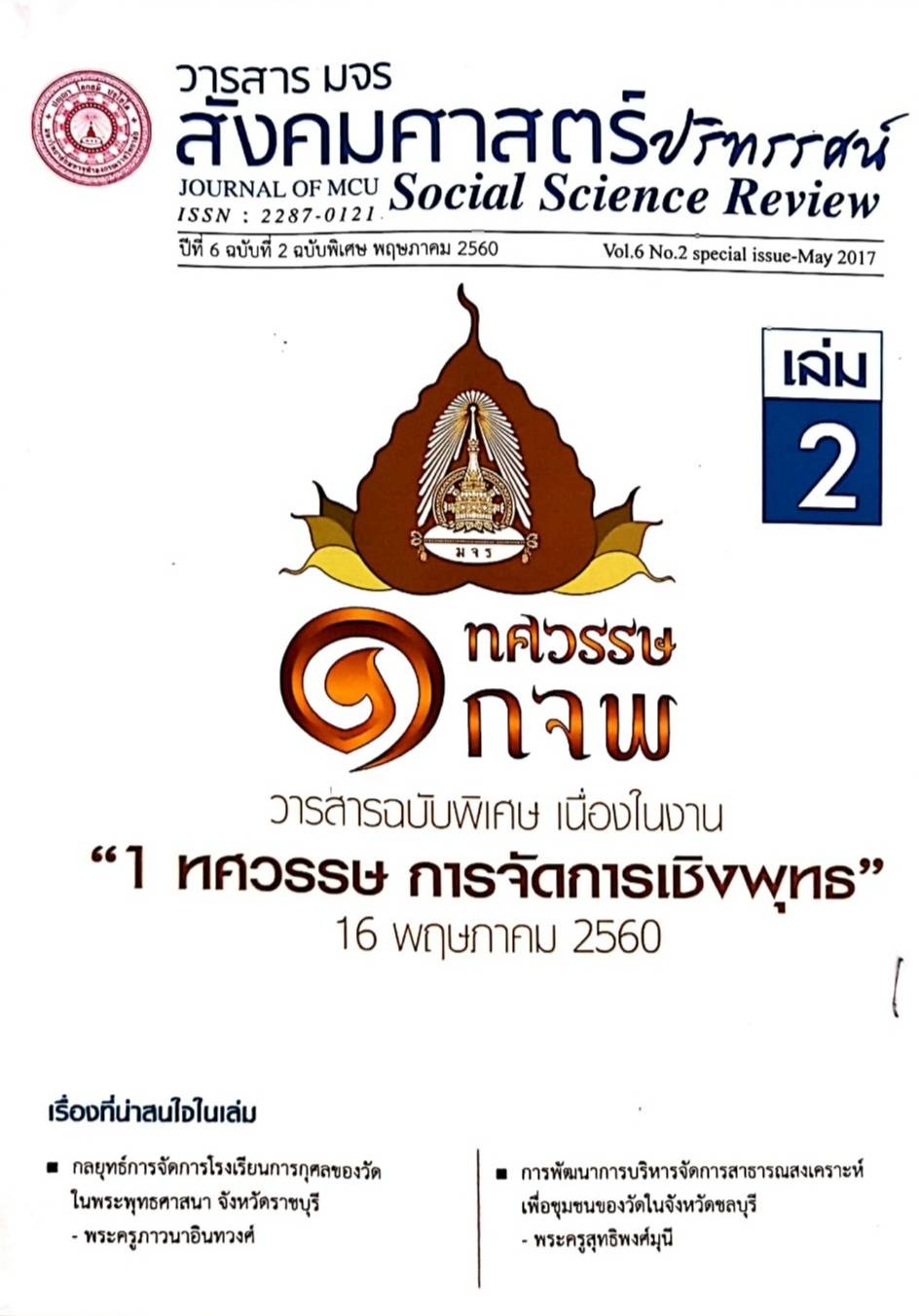ยุทธศาสตร์การบริหารงานเพื่อความเป็นเลิศของโรงเรียนพระปริยัติธรรม แผนกสามัญศึกษา
คำสำคัญ:
ยุทธศาสตร์, การบริหารงานเพื่อความเป็นเลิศ, โรงเรียนพระปริยัติธรรม แผนกสามัญ ศึกษาบทคัดย่อ
การวิจัยนี้มีวัตถุประสงค์คือ (1) เพื่อศึกษาสภาพทั่วไปและปัญหาอุปสรรคในการบริหารงานของโรงเรียนพระปริยัติธรรม แผนกสามัญศึกษา (2) เพื่อศึกษาหลักพุทธธรรม แนวคิดและทฤษฎีที่เกี่ยวข้องกับการบริหารงานของโรงเรียนพระปริยัติธรรม แผนกสามัญศึกษา (3) เพื่อนำเสนอยุทธศาสตร์ในการบริหารงานเพื่อความเป็นเลิศของโรงเรียนพระปริยัติธรรม แผนกสามัญศึกษา การวิจัยนี้เป็นการวิจัยเชิงคุณภาพ โดยแบ่งผู้ให้ข้อมูลหลักเป็น 2 กลุ่ม คือ (1) กลุ่มผู้ให้ข้อมูลหลักในการสัมภาษณ์ ประกอบด้วย ผู้อานวยการ รองผู้อำนวยการ และนักวิชาการด้านการศึกษาโรงเรียนพระปริยัติธรรม แผนกสามัญศึกษา จำนวน 25 รูป/คน (2) กลุ่มผู้ร่วมสนทนากลุ่มประกอบด้วย ผู้เชี่ยวชาญ และผู้ที่มีส่วนได้ส่วนเสีย จานวน 9 รูป/คน เก็บรวบรวมข้อมูลโดยใช้การสัมภาษณ์เจาะลึกและการสนทนากลุ่ม และวิเคราะห์ข้อมูลใช้วิธีการวิเคราะห์เนื้อหาเชิงพรรณา
ผลการวิจัยพบว่า
1) การบริหารงานของโรงเรียนพระปริยัติธรรม แผนกสามัญศึกษา พบว่า (1) การบริหารงานวิชาการและการจัดการศึกษาเน้นภาคทฤษฎีด้านองค์ความรู้มากเกินไป ขาดการเชื่อมโยงความรู้สู่การปฏิบัติ ผู้เรียนยังไม่ได้รับการสนับสนุนให้เกิดปัญญาพุทธธรรมเท่าที่ควรนอกจากนี้โรงเรียนยังไม่มีพระราชบัญญัติว่าด้วยการจัดการศึกษาเป็นการเฉพาะ ทำให้ครูไม่มีความมั่นคง จึงไม่ทุ่มเทในการสอน ส่งผลกระทบต่อการเรียนรู้ของนักเรียน เกิดปัญหาต่อการบริหารจัดการและพัฒนาคุณภาพมาตรฐานการศึกษาอย่างต่อเนื่อง (2) การบริหารงานบุคคลพบปัญหาคือผู้บริหารไม่ได้มาจากกระบวนการคัดเลือก คัดสรร แต่เจ้าอาวาสซึ่งเป็นผู้จัดการโรงเรียนเป็นผู้เลือกเอง อำนาจในการสั่งการบริหารส่วนใหญ่ขึ้นอยู่กับผู้จัดการหรือผู้อานวยการโรงเรียนเท่านั้นผู้บริหารมีความรู้และทักษะไม่เพียงพอต่อการบริหารจัดการให้ทันการเปลี่ยนแปลงและมีภาระงานมากทำให้ไม่มีเวลาในการบริหารจัดการที่เพียงพอ ปัญหาด้านครูคือ ครูไม่ได้มาจากระบบการคัดเลือกหรือคัดสรร เนื่องจากไม่มีการวางแผนอัตรากาลัง ครูขาดความมั่นคงและความก้าวหน้า
ด้านวิชาชีพ ไม่มีขวัญกาลังใจ ไม่ได้รับรายได้และสวัสดิการที่เหมาะสม ไม่ได้รับการพัฒนาความรู้ความสามารถในการจัดการเรียนการสอนที่เน้นผู้เรียนเป็นสำคัญ ทาให้ครูลาออกไปปฏิบัติงานอื่นที่มั่นคงกว่าและสถานภาพครูยังเป็นเพียงลูกจ้างของวัดหรือโรงเรียน (3) การบริหารงานงบประมาณพบปัญหาคือ งบประมาณไม่เพียงพอกับภาระงานและรูปแบบการจัดการเรียนการสอน เพราะรัฐอุดหนุนให้ในลักษณะเงินอุดหนุนรายหัวตามจำนวนนักเรียน ตลอดจนขาดระบบการบริหารจัดการการเงิน การบัญชีที่ได้มาตรฐาน เป็นธรรมาภิบาล และไม่มีแผนงานที่ชัดเจนในการบริหารจัดการระบบการเงินของโรงเรียน และ (4) การบริหารงานทั่วไป พบปัญหาคือ สื่อ อุปกรณ์ทางเทคโนโลยีอาคารสถานที่ไม่เพียงพอต่อการจัดการศึกษาและไม่เอื้อต่อการจัดการเรียนการสอน นอกจากนี้โรงเรียนยังขาดบุคลากรประจาที่ปฏิบัติหน้าที่ด้านเทคโนโลยีโดยตรง โรงเรียนยังขาดความพร้อมในการจัดทำระบบข้อมูลสารสนเทศเพื่อเป็นฐานข้อมูลในการบริหารจัดการศึกษา และการให้บริการประชาสัมพันธ์ โรงเรียนและกลุ่มโรงเรียนขาดการสร้างระบบเครือข่ายการวางแผนงานบริหารจัดการศึกษาร่วมกัน ขาดการวางนโยบายและแผนพัฒนาโรงเรียน ทั้งระดับโรงเรียนและระดับกลุ่มที่มีความชัดเจน
2) หลักพุทธธรรม แนวคิด และทฤษฎีที่เกี่ยวข้องกับการบริหารงานของโรงเรียนพระปริยัติธรรม แผนกสามัญศึกษา โดยนาหลักอริยสัจ 4 คือ ทุกข์ สมุทัย นิโรธ มรรค เข้ามาช่วยแก้ปัญหาการบริหารงานวิชาการ การบริหารงานบุคคล การบริหารงานงบประมาณ และการบริหารงานทั่วไป ดังนี้ ขั้นที่ 1 ทุกข์ คือการกำหนดปัญหาและจัดประเด็นปัญหา โดยศึกษาปัญหากำหนดขอบเขตที่จะแก้ ขั้นที่ 2 สมุทัย คือสาเหตุของปัญหา ร่วมคิดวิเคราะห์สาเหตุของปัญหาและการจัดลาดับความสำคัญของปัญหา/โดยการสำรวจความต้องการจาเป็นของโรงเรียน ปัญหามีความจำเป็นเร่งด่วนควรได้รับการแก้ไขตามลาดับ ขั้นที่ 3 นิโรธ การกำหนดจุดหมายหรือสภาวะพ้นปัญหา การร่วมคิด วิเคราะห์ ความเป็นไปได้ของการแก้ปัญหาและการจัดลาดับจุดหมายของสภาวะพ้นปัญหา ขั้นที่ 4 มรรค ขั้นลงมือแก้ปัญหา คือ การปฏิบัติเพื่อแก้ปัญหาตามแนวทางที่ถูกต้องเป็นการกำหนดวิธีการในรายละเอียดและปฏิบัติเพื่อกำจัดปัญหา พร้อมทั้งสรุปวิธีแก้ปัญหาและสรุปผล
3) ยุทธศาสตร์ในการบริหารงานเพื่อความเป็นเลิศของโรงเรียนพระปริยัติธรรม แผนกสามัญศึกษา แบ่งเป็น 4 ด้าน ได้แก่ (1) การสร้างและพัฒนาผู้เรียนให้เป็นศาสนทายาทที่มีคุณภาพได้แก่การพัฒนาผู้เรียนให้เป็นผู้เพียบพร้อมเป็นศาสนทายาทที่เปี่ยมปัญญาพุทธธรรมมีความรู้ความเข้าใจในหลักธรรมทางพระพุทธศาสนา เป็นผู้ที่ก้าวทันโลกอย่างรู้เท่าทันด้วยการเรียนรู้ตลอดชีวิต มีคุณธรรม จริยธรรม และมีระเบียบวินัยในตนเองสูง เป็นผู้ริเริ่ม สร้างสรรค์ และร่วมกันสร้างการเปลี่ยนแปลงทางสังคมสู่สังคมพุทธธรรมอย่างยั่งยืน (2) การพัฒนาระบบการบริหารโรงเรียนให้เข้มแข็ง และมีมาตรฐานเป็นโรงเรียนคุณภาพที่ยั่งยืน ได้แก่การบริหารจัดการโรงเรียนที่มีคุณภาพพร้อมทั้งมีระบบการจัดการศึกษาเป็นที่ยอมรับและเชื่อมั่นในคุณภาพมาตรฐานจากทุกภาคส่วนทั้งในและต่างประเทศ โดยผลิตผู้เรียนที่เป็นเด็กหรือเยาวชนให้เป็นมนุษย์ที่มีความสมบูรณ์ทั้งด้านอารมณ์ สังคม สติปัญญา มีความรู้ทั้งทางโลกและทางธรรม (3) การเสริมสร้างศักยภาพให้ประเทศไทยเป็นศูนย์กลางการศึกษาพระปริยัติธรรม แผนกสามัญศึกษา ได้แก่การพัฒนาโรงเรียนให้มีความพร้อมเป็นต้นแบบของการจัดการศึกษาพระปริยัติธรรม แผนกสามัญศึกษา นานาชาติ โดยมุ่งเน้นการพัฒนาหลักสูตร ระบบการจัดการศึกษา และการสานสัมพันธ์ที่ดีกับนานาอารยประเทศที่เหมาะสมและเป็นไปได้ และ (4) การทานุบำรุง เผยแผ่พระพุทธศาสนาให้เจริญงอกงาม ได้แก่การร่วมรับผิดชอบต่อการพัฒนาสังคมไทยให้เป็นสังคมเข้มแข็งอุดมปัญญาพุทธธรรมที่มีการศึกษาปฏิบัติธรรมเป็นวิถีชีวิตและมีอัตลักษณ์การปฏิบัติตนตามแนวศีล 5
เอกสารอ้างอิง
กลุ่มการศึกษาพระปริยัติธรรม แผนกสามัญศึกษา กองพุทธศาสนศึกษา สำนักงานพระพุทธศาสนาแห่งชาติ. (25587). แผนยุทธศาสตร์การจัดการศึกษาพระปริยัติธรรม แผนกสามัญศึกษา พ.ศ.2558-พ.ศ.2562. กรุงเทพมหานคร : โรงพิมพ์สำนักงานพระพุทธศาสนา
แห่งชาติ.
จุฬากรณ์ มาเสถียรวงศ์. (2549). นโยบายและยุทธศาสตร์ทางการศึกษาแบบมุ่งอนาคตเพื่อเด็กและเยาวชนไทย. วิทยานิพนธ์ครุศาสตรดุษฎีบัณฑิต สาขาวิชาพัฒนศึกษา.บัณฑิตวิทยาลัย : จุฬาลงกรณ์มหาวิทยาลัย.
ทรงพล เจริญคำ. (2552). “รูปแบบ ความเป็นเลิศของโรงเรียนสังกัดกรุงเทพมหานคร”. ปริญญาปรัชญาดุษฎีบัณฑิต สาขาวิชาบริหารการศึกษา. บัณฑิตวิทยาลัย : มหาวิทยาลัยศิลปากร.
ธนิก คุณเมธีกุล. (2552). การพัฒนาตัวบ่งชี้คุณภาพการบริหารการศึกษาเพื่อความเป็นเลิศของสถานศึกษาเอกชน. ปริญญาครุศาสตรดุษฎีบัณฑิต สาขาวิชาบริหารการศึกษา. บัณฑิตวิทยาลัย : จุฬาลงกรณ์มหาวิทยาลัย.
ธีระพร อายุวัฒน์. (2552). “แนวปฏิบัติที่เป็นเลิศในการบริหารงานวิชาการของสถานศึกษาขั้นพื้นฐานขนาดเล็ก”. ปริญญาปรัชญาดุษฎีบัณฑิต สาขาวิชาบริหารการศึกษา. บัณฑิตวิทยาลัย : มหาวิทยาลัยศิลปากร.
นงลักษณ์ เรือนทอง. (2550). “รูปแบบการบริหารโรงเรียนที่มีประสิทธิผล”. ปริญญาปรัชญาดุษฎีบัณฑิต สาขาวิชาบริหารการศึกษา. บัณฑิตวิทยาลัย : มหาวิทยาลัยศิลปากร.
ประวีณา ชะลุย. (2549). การนำเสนอยุทธศาสตร์การศึกษาเพื่อพัฒนากระบวนการชุมชนในการป้องกันการทุจริต. วิทยานิพนธ์ครุศาสตรดุษฎีบัณฑิต สาขาวิชาพัฒนศึกษา. บัณฑิตวิทยาลัย : จุฬาลงกรณ์มหาวิทยาลัย.
พนิดา คล้อสวัสดิ์. (2551). “ปัจจัยและแนวปฏิบัติที่เหมาะสมสาหรับการดำเนินการตามแผนยุทธศาสตร์ส่งเสริมการมีส่วนร่วมของเอกชนในการจัดการศึกษาขั้นพื้นฐาน ”.วิทยานิพนธ์ปรัชญาครุศาสตรดุษฎีบัณฑิต สาขาวิชาการบริหารการศึกษา. บัณฑิต
วิทยาลัย : จุฬาลงกรณ์มหาวิทยาลัย.
พระครูใบฎีกาบุญชู ชุติปญฺโญ (บุญยงค์). (2554). “รูปแบบการบริหารโรงเรียนพระปริยัติธรรมแผนกสามัญศึกษา”. วิทยานิพนธ์ครุศาสตรดุษฎีบัณฑิต สาขาวิชาการบริหารการศึกษา.บัณฑิตวิทยาลัย : มหาวิทยาลัยวงษ์ชวลิตกุล
พระมหาปัญญา ปญฺ าสิริ. (2557). “ประสิทธิผลการบริหารจัดการโรงเรียนพระปริยัติธรรม แผนกสามัญศึกษา ในเขตปกครองคณะสงฆ์ภาค 2”. วิทยานิพนธ์พุทธศาสตรดุษฎีบัณฑิตสาขาวิชาการจัดการเชิงพุทธ. บัณฑิตวิทยาลัย : มหาวิทยาลัยมหาจุฬาลงกรณราช
วิทยาลัย.
พระมหาสุทิน สุทิโน. (2556). “การบริหารจัดการเครือข่ายเชิงพุทธ ของกลุ่มโรงเรียนพระปริยัติธรรม แผนกสามัญศึกษา กลุ่ม 1”. วิทยานิพนธ์พุทธศาสตรดุษฎีบัณฑิต สาขาวิชารัฐประศาสนศาสตร์. บัณฑิตวิทยาลัย : มหาวิทยาลัยมหาจุฬาลงกรณราชวิทยาลัย.
พระมหาอานาจ ปวฑฺฒโน. (2556). “การพัฒนารูปแบบการจัดการการศึกษาพระปริยัติธรรม”,วิทยานิพนธ์พุทธศาสตรดุษฎีบัณฑิต สาขาวิชาการจัดการเชิงพุทธ. บัณฑิตวิทยาลัย :มหาวิทยาลัยมหาจุฬาลงกรณราชวิทยาลัย.
ดาวน์โหลด
เผยแพร่แล้ว
รูปแบบการอ้างอิง
ฉบับ
ประเภทบทความ
สัญญาอนุญาต
ลิขสิทธิ์ (c) 2020 วารสาร มจร สังคมศาสตร์ปริทรรศน์

อนุญาตภายใต้เงื่อนไข Creative Commons Attribution-NonCommercial-NoDerivatives 4.0 International License.
เพื่อให้เป็นไปตามกฎหมายลิขสิทธิ์ ผู้นิพนธ์ทุกท่านต้องลงลายมือชื่อในแบบฟอร์มใบมอบลิขสิทธิ์บทความให้แก่วารสารฯ พร้อมกับบทความต้นฉบับที่ได้แก้ไขครั้งสุดท้าย นอกจากนี้ ผู้นิพนธ์ทุกท่านต้องยืนยันว่าบทความต้นฉบับที่ส่งมาตีพิมพ์นั้น ได้ส่งมาตีพิมพ์เฉพาะในวารสาร มจร สังคมศาสตร์ปริทรรศน์ เพียงแห่งเดียวเท่านั้น หากมีการใช้ภาพหรือตารางหรือเนื้อหาอื่นๆ ของผู้นิพนธ์อื่นที่ปรากฏในสิ่งตีพิมพ์อื่นมาแล้ว ผู้นิพนธ์ต้องขออนุญาตเจ้าของลิขสิทธิ์ก่อน พร้อมทั้งแสดงหนังสือที่ได้รับการยินยอมต่อบรรณาธิการ ก่อนที่บทความจะได้รับการตีพิมพ์ หากไม่เป็นไปตามข้อกำหนดเบื้องต้น ทางวารสารจะถอดบทความของท่านออกโดยไม่มีข้อยกเว้นใดๆ ทั้งสิ้น





